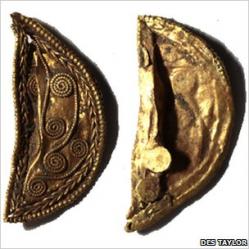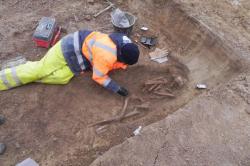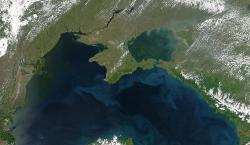- 07 JUILLET
- INDI-UNI : 
PRE-INSCRIPTION : 15 Juin – 15 Août
PRE-REGISTRATION: June 15th - August 15th
- ROYAUME UNI –  Bamburgh Castle - A decorative gold item believed to be about 1,200 years old has been found at a Northumberland archaeological dig.It was found at Bamburgh Castle and project director, Graeme Young, said it could date back to around 800AD. The 1.4cm (0.5 inch) piece of gold has yet to be properly identified or valued, but will go on show at the castle later this year. The unidentified piece has tiny beads of gold and spiral patterns.
Bamburgh Castle - A decorative gold item believed to be about 1,200 years old has been found at a Northumberland archaeological dig.It was found at Bamburgh Castle and project director, Graeme Young, said it could date back to around 800AD. The 1.4cm (0.5 inch) piece of gold has yet to be properly identified or valued, but will go on show at the castle later this year. The unidentified piece has tiny beads of gold and spiral patterns.
http://www.bbc.co.uk/news/uk-england-tyne-14046612
- BULGARIE –  Sozopol - Bulgarian archaeologists have unearthed the main church of a 14th century Byzantine monastery built by the last dynasty of the Eastern Roman Empire located in the Black Sea town of Sozopol. The team of archaeologist Dr. Krastina Panayotova from the National Archaeology Institute of the Bulgarian Academy of Sciences has completed the first stage of the excavations of the St. Apostles Monastery and of a medieval feudal castle at the Cape of Sozopol. During the excavations funded by the Bulgarian government, Panayotova's team has uncovered the monastery church, a small cemetery chapel, and a feudal castle dating back to the 13th-15th century, the last days before the Byzantine Empire before it was wiped out of the map by the Ottoman Turkish invaders. Today's Bulgarian resort towns of Sozopol and Nessebar themselves were among the last Byzantine possessions to be conquered by the Ottoman Turks – they fell only in 1459 AD, 6 years after Constantinople. The two towns were first conquered by the First Bulgarian Empire in the Middle Ages but their possession went back and forth between Bulgaria and Byzantium. The newly-uncovered church of the medieval St. Apostles monastery was built around 1335 AD by Anasthasius Palaiologos, uncle of the Byzantine Emperor John V Palaiologos (r. 1341-1391), and a relative of the Bulgarian Tsar Mihail Shishman (r. 1323-1330). the church was the largest and most beautiful church along the Bulgarian Black Sea coast. It is 24 m long and 16 m wide, and is located on the Cape of Sozopol. Thus, it could be seen from all towns in the entire Gulf of Burgas – from the Cape of Emine to the Cape of Maslen Nos. A total of 120 dignitaries were buried near the church; most of them were military officers because they were found to have been wearing boots with iron attachments. The Bulgarian archaeologists have found that one of them was buried with a sophisticated medallion depicting the Birth of Christ, and the grave of a young woman contained a bad with 65 silver and copper coins.
Sozopol - Bulgarian archaeologists have unearthed the main church of a 14th century Byzantine monastery built by the last dynasty of the Eastern Roman Empire located in the Black Sea town of Sozopol. The team of archaeologist Dr. Krastina Panayotova from the National Archaeology Institute of the Bulgarian Academy of Sciences has completed the first stage of the excavations of the St. Apostles Monastery and of a medieval feudal castle at the Cape of Sozopol. During the excavations funded by the Bulgarian government, Panayotova's team has uncovered the monastery church, a small cemetery chapel, and a feudal castle dating back to the 13th-15th century, the last days before the Byzantine Empire before it was wiped out of the map by the Ottoman Turkish invaders. Today's Bulgarian resort towns of Sozopol and Nessebar themselves were among the last Byzantine possessions to be conquered by the Ottoman Turks – they fell only in 1459 AD, 6 years after Constantinople. The two towns were first conquered by the First Bulgarian Empire in the Middle Ages but their possession went back and forth between Bulgaria and Byzantium. The newly-uncovered church of the medieval St. Apostles monastery was built around 1335 AD by Anasthasius Palaiologos, uncle of the Byzantine Emperor John V Palaiologos (r. 1341-1391), and a relative of the Bulgarian Tsar Mihail Shishman (r. 1323-1330). the church was the largest and most beautiful church along the Bulgarian Black Sea coast. It is 24 m long and 16 m wide, and is located on the Cape of Sozopol. Thus, it could be seen from all towns in the entire Gulf of Burgas – from the Cape of Emine to the Cape of Maslen Nos. A total of 120 dignitaries were buried near the church; most of them were military officers because they were found to have been wearing boots with iron attachments. The Bulgarian archaeologists have found that one of them was buried with a sophisticated medallion depicting the Birth of Christ, and the grave of a young woman contained a bad with 65 silver and copper coins.
http://www.novinite.com/view_news.php?id=130003
- EGYPTE – Alexandrie - Egyptian officials say archaeologists have unearthed the first basilica erected in the Mediterranean port city of Alexandria. The Antiquities Authority says the basilica is dated to the Roman era and was built on the ruins of a temple from the Ptolemaic reign that ended with the death of Cleopatra. A statement Thursday says two parallel rows of granite and limestone pillars suggest the basilica was a social site that was also used for trade and judicial matters. It says several statues of the Ancient Egyptian goddess Isis — one showing her breast-feeding — and others of the Graeco-Egyptian god Serapis also have been unearthed during five months of excavations that ended in May when archaeologists hit underground water.
http://www.google.com/hostednews/ap/article/ALeqM5gvpLdL3Y7I7XtpBurhEc8y3t1Zww?docId=cdcd69ef4f5544c0b972b25f5262cac4
- FRANCE –  Saint Martin sur le Pré - Rien, ni même les photographies aériennes, ne laissait présager que la commune de Saint-Martin-sur-le-Pré avait accueilli autant de peuplades par le passé. Les fouilles archéologiques menées rue des Castors touchent à leur fin, et la Ric prendra bientôt le relai. Pour la petite histoire, c'est un diagnostic mené par l'Inrap en 2007 qui révèlera le potentiel archéologique du terrain situé rue des Castors. Diagnostic réalisé suite à un projet de programme immobilier, et suite auquel la Drac prescrira une fouille en bonne et due forme de la zone concernée. Les archéologues de Reims Métropole, la collectivité missionnée sur ce dossier, ont donc exploré les fins fonds de 4.500 m2 de novembre à janvier et achèveront leurs recherches sur les 900 m2 restants en août et septembre. De surprenants résultats ! « Nous avons creusé jusqu'au sol naturel, et découvert nombre de vestiges datés d'au moins quatre époques différentes » explique Nicolas Garmond, néolithicien responsable de l'opération. Les plus anciens Saint-Martinais auraient ainsi vécu entre 5100 et 4800 avant J.C., à l'époque des premières occupations sédentaires liées à l'affluence des fleuves, et ici, de la Marne « puisqu'elle passait dans l'actuel canal Saint-Martin jusqu'en 1777 », précise Jacques Jesson, maire de la commune. Et les traces retrouvées grâce aux fouilles en témoignent : une maison danubienne d'au moins 30 mètres de long, deux sépultures, des bijoux en perles de coquillages, des outils en silex, etc. Plusieurs bâtiments auront aussi accueilli des familles d'agriculteurs à l'Âge de Bronze, et la dernière occupation humaine constatée sur le site s'apparente à une ferme gallo-romaine du 1er siècle après J.C. « Nous avons également décelé des vases, tasses, et assiettes décorées, ainsi qu'un chien, enterré. Preuve qu'à l'époque, l'affection des humains pour les animaux domestiqués existait déjà ! », raconte l'historien.
Saint Martin sur le Pré - Rien, ni même les photographies aériennes, ne laissait présager que la commune de Saint-Martin-sur-le-Pré avait accueilli autant de peuplades par le passé. Les fouilles archéologiques menées rue des Castors touchent à leur fin, et la Ric prendra bientôt le relai. Pour la petite histoire, c'est un diagnostic mené par l'Inrap en 2007 qui révèlera le potentiel archéologique du terrain situé rue des Castors. Diagnostic réalisé suite à un projet de programme immobilier, et suite auquel la Drac prescrira une fouille en bonne et due forme de la zone concernée. Les archéologues de Reims Métropole, la collectivité missionnée sur ce dossier, ont donc exploré les fins fonds de 4.500 m2 de novembre à janvier et achèveront leurs recherches sur les 900 m2 restants en août et septembre. De surprenants résultats ! « Nous avons creusé jusqu'au sol naturel, et découvert nombre de vestiges datés d'au moins quatre époques différentes » explique Nicolas Garmond, néolithicien responsable de l'opération. Les plus anciens Saint-Martinais auraient ainsi vécu entre 5100 et 4800 avant J.C., à l'époque des premières occupations sédentaires liées à l'affluence des fleuves, et ici, de la Marne « puisqu'elle passait dans l'actuel canal Saint-Martin jusqu'en 1777 », précise Jacques Jesson, maire de la commune. Et les traces retrouvées grâce aux fouilles en témoignent : une maison danubienne d'au moins 30 mètres de long, deux sépultures, des bijoux en perles de coquillages, des outils en silex, etc. Plusieurs bâtiments auront aussi accueilli des familles d'agriculteurs à l'Âge de Bronze, et la dernière occupation humaine constatée sur le site s'apparente à une ferme gallo-romaine du 1er siècle après J.C. « Nous avons également décelé des vases, tasses, et assiettes décorées, ainsi qu'un chien, enterré. Preuve qu'à l'époque, l'affection des humains pour les animaux domestiqués existait déjà ! », raconte l'historien.
http://www.lhebdoduvendredi.com/?typepage=article&id=4041
- VIET NAM –  Quang Ngai - Antiques from 1000 BC have been unearthed at a mountainous site in the central province of Quang Ngai. Researcher Doan Ngoc Khoi, from Quang Ngai Museum, said 10 tombs containing objects from 3,000 years ago had been found at an archaeological site in the bed of Nuoc Trong Lake, in Tay Tra District. The antiques were similar to those of the pre-Sa Huynh culture period, which helped confirmed that such a culture flourished even in mountainous areas. Previously, antiques of that time had been found only on the plains and in coastal areas. Archaeologist Nguyen The Phong noted the objects bore unique decorative fine patterns, which were similar to objects found at another site in Pho Thanh Commune, Duc Pho District, in the same province. Yet they were somewhat different with distinctive features of the locality. Sa Huynh culture flourished in central and southern Viet Nam between 1000BC until the late second century. It is one of the three ancient cradles of civilisation in Viet Nam. The Sa Huynh people are thought to be predecessors of the Cham, the founders of the Champa Kingdom that flourished in the country from AD 132 until the 18th century.
Quang Ngai - Antiques from 1000 BC have been unearthed at a mountainous site in the central province of Quang Ngai. Researcher Doan Ngoc Khoi, from Quang Ngai Museum, said 10 tombs containing objects from 3,000 years ago had been found at an archaeological site in the bed of Nuoc Trong Lake, in Tay Tra District. The antiques were similar to those of the pre-Sa Huynh culture period, which helped confirmed that such a culture flourished even in mountainous areas. Previously, antiques of that time had been found only on the plains and in coastal areas. Archaeologist Nguyen The Phong noted the objects bore unique decorative fine patterns, which were similar to objects found at another site in Pho Thanh Commune, Duc Pho District, in the same province. Yet they were somewhat different with distinctive features of the locality. Sa Huynh culture flourished in central and southern Viet Nam between 1000BC until the late second century. It is one of the three ancient cradles of civilisation in Viet Nam. The Sa Huynh people are thought to be predecessors of the Cham, the founders of the Champa Kingdom that flourished in the country from AD 132 until the 18th century.
http://vietnamnews.vnagency.com.vn/Life-Style/213006/3000-year-old-artefacts-unearthed-.html
- BULGARIE –  Mer Noire - Bulgarian scientists have found the ancient shores of the Black Sea, currently deep beneath the waves, which they claim were the original shores about 7500 years ago, when the Black Sea at the time was just a fresh water lake. The team, led by Professor Petko Dimitrov of the Institute of Oceanology in Varna, saying that they have found the ancient coastline close to the Cape of Emine. Archaeological evidence suggest that this particular spot was part of the ancient coastline. The common theory of the creation of the Black Sea says that there was a massive deluge through the straits of Bosporus (modern Istanbul), where waters from the Mediterranean flooded into the lake. Once the Mediterranean Sea breached the Bosporus Strait, it irreversibly changed the history of the people in the area, as well as the flora and fauna. In 1997, William Ryan and Walter Pitman published evidence that a massive flooding of the Black Sea occurred about 5600 BCE through the Bosporus. According to the theory, glacial melt-water had turned the Black and Caspian Seas into vast freshwater lakes draining into the Aegean Sea before that event. As glaciers retreated, some of the rivers emptying into the Black Sea declined in volume and changed course to drain into the North Sea. Scientists believe that if this theory proves true, they will be presented with a myriad of other questions, such as who lived there, the fate of the people in the area and how the region was affected in the aftermath.
Mer Noire - Bulgarian scientists have found the ancient shores of the Black Sea, currently deep beneath the waves, which they claim were the original shores about 7500 years ago, when the Black Sea at the time was just a fresh water lake. The team, led by Professor Petko Dimitrov of the Institute of Oceanology in Varna, saying that they have found the ancient coastline close to the Cape of Emine. Archaeological evidence suggest that this particular spot was part of the ancient coastline. The common theory of the creation of the Black Sea says that there was a massive deluge through the straits of Bosporus (modern Istanbul), where waters from the Mediterranean flooded into the lake. Once the Mediterranean Sea breached the Bosporus Strait, it irreversibly changed the history of the people in the area, as well as the flora and fauna. In 1997, William Ryan and Walter Pitman published evidence that a massive flooding of the Black Sea occurred about 5600 BCE through the Bosporus. According to the theory, glacial melt-water had turned the Black and Caspian Seas into vast freshwater lakes draining into the Aegean Sea before that event. As glaciers retreated, some of the rivers emptying into the Black Sea declined in volume and changed course to drain into the North Sea. Scientists believe that if this theory proves true, they will be presented with a myriad of other questions, such as who lived there, the fate of the people in the area and how the region was affected in the aftermath.
http://www.sofiaecho.com/2011/07/07/1119372_archaeology-black-seas-ancient-coast-found-report